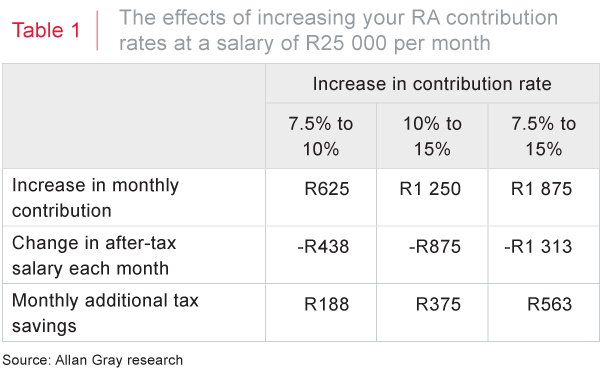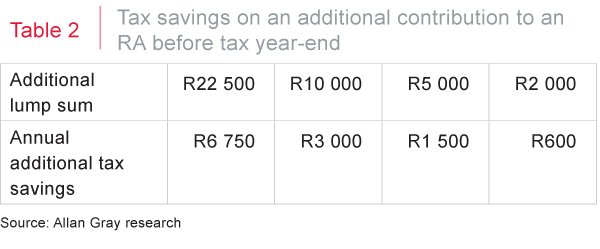In light of changes to the legislation governing retirement funds, which now limits the exposure individuals may have to various asset classes (e.g. a maximum of 75% to equities), we recently investigated whether retirement annuities (RAs) are still a good choice for investors looking to maximise long-term returns (see Quarterly Commentary 3, 2011). The key question we interrogated was whether the benefits of an RA, with a maximum of 75% equity exposure, outweigh the potential for higher returns from full exposure to equities. Through this investigation we confirmed that while individuals in low income tax brackets with very long-term investment horizons may benefit from investing in more flexible investment products, most investors are still better off in an RA. Also, investors who do choose alternative products forgo the key benefits offered by RAs, i.e. tax efficiency and protection of their retirement savings.
A tax-efficient way to save
One of the biggest advantages of RAs is that by making contributions to an RA you may pay less tax or you could receive money back from SARS at the end of the tax year. If you contribute to your employer’s pension or provident fund you can also contribute to an RA. You are allowed tax deductions on RA contributions of up to 15% of any additional income that is not used to calculate your pension or provident fund contributions, such as a bonus, car allowance or commission. If your employer does not offer a pension or provident fund, contributions of up to 15% of your full salary are tax deductible. Income earned on your investment over the time up to when you retire is also tax free. At retirement you will need to transfer at least two-thirds of your investment into a pension-providing investment product. The income payments you receive will be taxed at your marginal income tax rate, which is often lower after retirement.
RAs safeguard your retirement investment
In addition to tax advantages, RAs also protect your retirement investment as you cannot usually access your money before you retire unless you are permanently disabled, or you are emigrating. The temptation to withdraw money when times are tough should not be underestimated. RAs also offer protection from others – creditors cannot access the money in an RA.
Consider increasing your monthly contribution rate or making an additional contribution before the end of the tax year
While most investors seem to understand the need to contribute as much as possible, and to start saving as soon as possible, many still contribute less than the maximum tax-deductible amount to their RAs. Understandably, investors need to balance the tax savings with their immediate cash flow requirements. Table 1 quantifies the benefit of thinking for the long term. The table shows that as you increase your contribution your cash flow naturally decreases, but your contribution goes up by more than your cash flow goes down. This is because increasing your contribution rate decreases your tax liability, which means that you can think of the difference as SARS’ contribution to your retirement savings.

By budgeting carefully you may be able to free up extra cash for saving for your retirement. A higher contribution rate can make a big difference to your overall investment value in the long run. You can take best advantage of the tax savings in an RA by contributing the maximum tax-deductible amount each month. However, if your circumstances don’t allow you to tolerate lower cash flow every month, contributing as much as you can when you can in the form of an additional contribution, still allows you to take advantage of the tax benefits. Table 2 shows the additional tax savings possible through an additional contribution for an individual earning R25 000 and contributing 7.5% to an RA each month.

In this case, contributing the maximum additional lump sum allowed (R22 500) would result in tax savings of R6 750. But even the lower tax savings on small contributions before the tax year-end helps – keeping in mind that every little bit counts.
If you would like to open an RA or make an additional contribution to your existing RA before the end of the 2011/2012 tax year, please ensure that your instruction and payment reach us before 14:00 on Wednesday 29 February 2012 (EFTs may take up to two days to reflect in the Fund’s bank account). Remember you will need to ensure that your RA has the right mix of assets as set out in revised retirement fund regulations (Regulation 28 of the Pension Funds Act).
Allan Gray Proprietary Limited is an authorised financial services provider